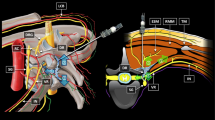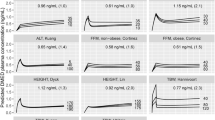Abstract
Purpose
Although laparoscopic surgery is minimally invasive, it produces stress responses to an extent similar to that of conventional laparotomy. Both epidural anesthesia and remifentanil intravenously (i.v.), combined with general anesthesia, provide stable hemodynamics during laparoscopic surgery. However, it has not been elucidated whether epidural anesthesia and remifentanil are associated with suppression of autonomic and neuroendocrine stress responses. This study aimed to clarify whether thoracic epidural anesthesia (TEA) or remifentanil suppresses stress responses during laparoscopic surgery.
Methods
We assigned 60 patients undergoing laparoscopic colectomy to three groups anesthetized with 40 % oxygen–air–sevoflurane plus either TEA (TEA group), continuous infusion of remifentanil 0.25 μg/kg/min [low-dose (LD) group], or 1.0 μg/kg/min [high-dose (HD) group] (n = 20 each group). Plasma concentrations of adrenocorticotropic hormone (ACTH), cortisol, antidiuretic hormone (ADH), and catecholamines were measured immediately before anesthesia induction, and 30 and 90 min after the start of pneumoperitoneum.
Results
All groups showed no significant changes in hemodynamics during the course of anesthesia. Compared with TEA, both high-dose and low-dose remifentanil significantly suppressed increases in ACTH, ADH, and cortisol during pneumoperitoneum. Plasma adrenaline showed no significant changes during pneumoperitoneum in any group. Compared with TEA, low-dose remifentanil produced significantly higher plasma concentrations of noradrenaline and dopamine during pneumoperitoneum.
Conclusion
Notwithstanding similar hemodynamic responses in all groups, only high-dose remifentanil suppressed both sympathetic responses and the hypothalamus–pituitary–adrenal axis. This result indicates that of these three anesthesia regimens, high-dose remifentanil seems most suited for laparoscopic surgery.



Similar content being viewed by others
References
Berggren U, Gordh T, Grama D, Haglund U, Rastad J, Arvidsson D. Laparoscopic versus open cholecystectomy: hospitalization, sick leave, analgesia and trauma responses. Br J Surg. 1994;81:1362–5.
Schirmer BD, Edge SB, Dix J, Hyser MJ, Hanks JB, Jones RS. Laparoscopic cholecystectomy. Treatment of choice for symptomatic cholelithiasis. Ann Surg. 1991;213:665–76.
Marana E, Colicci S, Meo F, Marana R, Proietti R. Neuroendocrine stress response in gynecological laparoscopy: TIVA with propofol versus sevoflurane anesthesia. J Clin Anesth. 2010;22:250–5.
Mendoza-Sagaon M, Hanly EJ, Talamini MA, Kutka MF, Gitzelmann CA, Herreman-Suquet K, Poulose BF, Paidas CN, De Maio A. Comparison of the stress response after laparoscopic and open cholecystectomy. Surg Endosc. 2000;14:1136–41.
Karayiannakis AJ, Makri GG, Mantzioka A, Karousos D, Karatzas G. Systemic stress response after laparoscopic or open cholecystectomy: a randomized trial. Br J Surg. 1997;84:467–71.
Donald RA, Perry EG, Wittert GA, Chapman M, Livesey JH, Ellis MJ, Evans MJ, Yandle T, Espiner EA. The plasma ACTH, AVP, CRH and catecholamine responses to conventional and laparoscopic cholecystectomy. Clin Endocrinol. 1993;38:609–15.
Aono H, Takeda A, Tarver SD, Goto H. Stress responses in three different anesthetic techniques for carbon dioxide laparoscopic cholecystectomy. J Clin Anesth. 1998;10:546–50.
Hall G, Lacoumenta S, Hart G, Burrin J. Site of action of fentanyl in inhibiting the pituitary-adrenal response to surgery in man. Br J Anaesth. 1990;65:251–3.
Marana E, Scambia G, Colicci S, Maviglia R, Maussier ML, Marana R, Proietti R. Leptin and perioperative neuroendocrine stress response with two different anaesthetic techniques. Acta Anaesthesiol Scand. 2008;52:541–6.
Giesecke K, Hamberger B, Järnberg P, Klingstedt C, Persson B. High- and low-dose fentanyl anaesthesia: hormonal and metabolic responses during cholecystectomy. Br J Anaesth. 1988;61:575–82.
Myre K, Raeder J, Rostrup M, Buanes T, Stokland O. Catecholamine release during laparoscopic fundoplication with high and low doses of remifentanil. Acta Anaesthesiol Scand. 2003;47:267–73.
Marana E, Annetta M, Marana R, Maussier M, Galeone M, Mensi S, D’Angelo F, Proietti R. Neuroendocrine stress response in laparoscopic surgery for benign ovarian cyst. Can J Anaesth. 2004;51:943–4.
Weale NK, Rogers CA, Cooper R, Nolan J, Wolf AR. Effect of remifentanil infusion rate on stress response to the pre-bypass phase of paediatric cardiac surgery. Br J Anaesth. 2004;92:187–94.
Rademaker BM, Ringers J, Odoom JA, de Wit LT, Kalkman CJ, Oosting J. Pulmonary function and stress response after laparoscopic cholecystectomy: comparison with subcostal incision and influence of thoracic epidural analgesia. Anesth Analg. 1992;75:381–5.
Ahlers O, Nachtigall I, Lenze J, Goldmann A, Schulte E, Hohne C, Fritz G, Keh D. Intraoperative thoracic epidural anaesthesia attenuates stress-induced immunosuppression in patients undergoing major abdominal surgery. Br J Anaesth. 2008;101:781–7.
Chae BK, Lee HW, Sun K, Choi YH, Kim HM. The effect of combined epidural and light general anesthesia on stress hormones in open heart surgery patients. Surg Today. 1998;28:727–31.
Segawa H, Mori K, Kasai K, Fukata J, Nakao K. The role of the phrenic nerves in stress response in upper abdominal surgery. Anesth Analg. 1996;82:1215–24.
Kainuma E, Watanabe M, Tomiyama-Miyaji C, Inoue M, Kuwano Y, Ren H, Abo T. Association of glucocorticoid with stress-induced modulation of body temperature, blood glucose and innate immunity. Psychoneuroendocrinology. 2009;34:1459–68.
Deuss U, Dietrich J, Kaulen D, Frey K, Spangenberger W, Allolio B, Matuszczak M, Troidl H, Winkelmann W. The stress response to laparoscopic cholecystectomy: investigation of endocrine parameters. Endoscopy. 1994;26:235–8.
Weissman C. The metabolic response to stress: an overview and update. Anesthesiology. 1990;73:308–27.
Van Loon GR. Plasma dopamine: regulation and significance. Fed Proc. 1983;42:3012–8.
Desborough J. The stress response to trauma and surgery. Br J Anaesth. 2000;85:109–17.
Author information
Authors and Affiliations
Corresponding author
About this article
Cite this article
Watanabe, K., Kashiwagi, K., Kamiyama, T. et al. High-dose remifentanil suppresses stress response associated with pneumoperitoneum during laparoscopic colectomy. J Anesth 28, 334–340 (2014). https://doi.org/10.1007/s00540-013-1738-x
Received:
Accepted:
Published:
Issue Date:
DOI: https://doi.org/10.1007/s00540-013-1738-x




